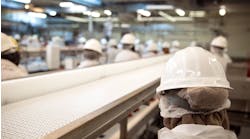Welcome back to the Food For Thought podcast. In this episode, sponsored by EnSight Solutions, we’re talking with Heath Clifton, Director of Automation and Controls about food-safe robotics. We talk about what food-safe robotics are as well as the difference between hygienic and sanitary robotics before turning our attention toward the key features processors should they look for when evaluating robotics. Enjoy the episode.
Transcript
Food Processing: Welcome to the Food for Thought podcast. Let's kick things off by having you explain what food-safe robotics are.
Heath Clifton: Food safe robotics would be a robot that is designed to be on the primary side of an application, which is generally a place where it's direct product contact. It's an area that gets washed down daily, high pressure spray, warm water. It's a robot that can get wet. Generally, if you're going to look at IP ratings, it's going to be in the IP67, IP69K rating. It's going to be hygienically designed, it's going to be sanitary. It's going to be ready to meet all those conditions without having to be bagged or something different done to it. Just like the rest of the equipment that's on the line, you want it to be able to be disassembled and sprayed down without any extra effort put into sectioning it off.
FP: Can you explain the difference between hygienic and sanitary, particularly as it relates to food safe robotics?
HC: Absolutely. I think a lot of people, when they look at robotics or even any equipment that goes into a primary side application, they talk about IP ratings. IP69K, IP67 are generally the ratings that people look for, and they think once they have these IP ratings and they put them into their application, that they're perfect and they're ready to go, and that that's not necessarily the case. The IP rating really only relates to it getting wet and having water on it.
How long can it be submerged in water and still work correctly? When you're referencing something being hygienic, what really comes into play is the cleanability, how it's shaped. For something to be hygienic, you want it to be smooth surfaces, rounded surfaces, things that don't have harborage points and there aren't any places for water to sit. When it comes to sanitary design, it really goes along with those same things. There's not harbor points. It's a piece of equipment that can hold up to not only the water, but also the caustic chemicals. Lots of times, especially meat processors, they're going to be using caustic chemicals to clean, get rid of any bacteria or anything in there. So for a robot to be hygienic and sanitary, it's easily cleanable, can stand up to not just the water, but also the caustic chemicals that go along with it.
FP: If food processors were considering this option, what key features should they look for when evaluating robotics?
HC: I think it goes back to a lot of things I was just kind of referencing. Everybody always looks for the IP rating at first, so you're going to want one that's IP67 or IP69K. I don't know who decided to start marketing IP69K for the food industry, but they should be given an award because everybody thinks it has to be IP69K for it to go on a primary side environment, and that's definitely not the case. IP67 is a perfectly acceptable washdown rating, so you really want to look for one of those two ratings. You want it to be stainless steel or you want it to have some sort of special coating to be able to, again, stand up to the cuastic chemicals. Obviously, there are different ratings of stainless that you're going to look for when it comes to wash down and chemicals.
There are some robots out there that have special coatings that aren't made out of stainless that are ready to be put in a washdown environment. I think, again, people get caught up on it has to be stainless steel, otherwise it's not going to work, and that that's not necessarily the case. Some other key features when you go to evaluating a robot is the integrator that you use as well. Who is the person that's going to be designing it for you, putting it in for you? Do they have experience in the food industry? I would say that's a challenge with a lot of end users is that they have this integrator that has maybe done robot programming for years, but they're not used to the food industry. They don't understand the standards and what exactly happens when things get cleaned. They don't design for sanitary and hygienic purposes.
So there's definitely lots of features to look for, and it's not just the robot itself. It's who is doing the robot programming. Are they making it easy for your application? Are they making it in a way that it can be cleaned and easily cleanable as well?
FP: When it comes to food safety and robotics, what does it mean to be a trusted partner?
HC: For us, being a trusted partner is knowing what it is you're trying to build. We work very closely with our customers to try to understand exactly what they need. Many times customers come to us and they say, "Hey, we really need this thing." And once we dig into what they're wanting, what they need, there might be other aspects of it that they haven't looked at or thought about. So it's really bringing that experience and really partnering with a customer. We just don't want to sell a piece of equipment to you and just move on to the next one. We want to design something for you that is going to make your life easier. It's going to make the day-to-day production better.
It's going to make all aspects of it, maintenance, sanitation, all quality. We want to design and build something and give our customers a good feeling that when it gets put in and when they're running it, that they know that everything's going to work. And then if they do have issues, they can come back to us. We'll be there to work with them on it, understand what the issues are, and then be able to fix it as quickly as possible and get them back up and running, and hopefully onto some more projects that we can help with.


